2019 MERCEDES-BENZ CLA COUPE child lock
[x] Cancel search: child lockPage 9 of 330

Roof
lining ...................................... 272
Se at belt ........................................ 271
Seat cover .....................................2 71
Sensors ......................................... 269
Steering wheel....... ........................271
Trim pieces ....... .............................271
Was hing byhand ........................... 266
Whee ls....... ....................................268
Windo ws....... ................................. 268
Wip erbla des ....... ........................... 269
Wood entrim .................................. 271
Cargo compartm entenlargemen t... 242
Cargo tiedow nrings .........................243
CD
see also Digita lOpera tor'sMan-
ua l....... ...........................................231
CD player (on-bo ardcomputer) ........185
Ce nter conso le
Lowe rsection .................................. 36
Uppe rsection .................................. 35
Ce ntral locking
Automa ticlocking (on-boardcom-
pute r)....... ......................................189
Locking/u nlocking(SmartKe y)....... .70
Cha nge ofaddress .............................. 26
Cha nge ofowner ship.......................... 26
Cha nging awheel
Wheel sand tires ............................ 311
Child
Rest raintsyst em.............................. 56
Child seat
For ward- facing restraint system...... 59
LA TCH- type (ISOF IX) child seat
anc hors............................................ 57
On thefron t-passe nger seat ............ 58
Rearwar d-facin gres traint system.... 59
Top Tether ...................................... .5 7
Child -proof locks
Imp ortant safe tyno tes.................... 59
Rear doors.......................................6 0
Child ren
Spe cial seat beltretrac tor...............5 5
Child reninthevehi cle
Imp ortant safe tyno tes.................... 54
Cigar ettelight er................................ 247
Cleani ng
Mirr ortur nsign al...........................2 69 Cl
imate control
Air-conditi oningsystem .................112
Automa ticclima tecontrol (dual-
zone) ..............................................114
Control lingautomatica lly....... ........117
Coo ling with airdehu midificati on.. 116
Defrosting thewindows .................119
Defrosting thewindshi eld....... ....... 118
Gene ralnotes ................................ 111
Indica torlamp ....... .........................117
Informati onabo utusi ng auto-
matic climatecontrol ..................... 115
Maxi mum cooling....... ................... 119
Notes onusing the air-conditio n-
ing system .....................................113
Overvi ewofsys tems ......................111
Prob lemwith the rear window
defro ster........................................ 120
Prob lems with cooli ngwith air
dehu midificati on....... ..................... 117
Ref rige rant .....................................324
Ref rige rant filling capa city....... ...... 324
Setting theairdis tribu tion............. 117
Setting theairvents ......................121
Setting theairflow ......................... 118
Setting thetempera ture................117
Switchi ngair-recircu lation mode
on/off ............................................120
Switchi ngon/off ........................... 116
Switchi ngresi dua lhea ton/off ......120
Switchi ngthe rear window
defro steron/off ............................ 119
Switchi ngthe ZONE function
on/off ............................................118
Co ckpit
Overvi ew....... ................................... 32
see Instrument cluster
COMA NDdisplay
Cl eani ng....... .................................. 270
Co mbinati onswi tch ....... ................... 102
Co mpass
Ca librating .....................................258
Ca lling up ....... ................................258
Mag netic fieldzone maps....... ....... 258
Setting ...........................................258
Co nne ctin gaUSB device
see also Digita lOpera tor'sMan-
ua l....... ...........................................231 In
dex
7
Page 42 of 330

Panic
alarm X
To activate: pressandhold the
0033 button 0043for approx. onesecond.
A visual andaudib lealarm istriggered ifthe
alarm system isarmed.
X To deactivat e:press 0033button 0043again.
or X Insert theSmartK eyinto theignition lock.
or, invehicles withKEYLE SS-GO start- function
or KEYLE SS‑GO
X Press theStart /Stopbutton.
The SmartK eymust beinthe vehicle. Occupant
safety Introduct
iontothe restr aintsystem
The restraint systemcanreduce therisk ofvehi-
cle occupants comingintocont actwith parts of
the vehicle's interiorinthe event ofan accident.
The restraint systemcanalso reduce theforces
to which vehicle occupants aresubjected during
an accident.
The restraint systemcomprises:
R Seat beltsystem
R Air bags
R Child restraint system
R Child seatsecuring systems
The componen tsof the restraint systemworkin
conj unction witheach other. Theycanonly
deploy theirprotect ivefunct ionif,at all times, all
vehicle occupants:
R have fastened theirseatbelts correct ly
(Y page 43)
R have theseat andhead restraint adjusted
properly (Ypage 91) As
the driver, youalso have tomake surethat
the steering wheelisadjusted correctly.
Observe theinformation relatingtothe correct
driver's seatposition (Ypage 91).
You also have tomake surethatanair bag can
inflate properly ifdeploye d(Y page 45).
An airbag supplements acorrect lyworn seat
belt. Asanadditional safetydevice, theairbag
increases thelevel ofprotect ionforvehicle
occupants inthe event ofan accident. Forexam-
ple, if,inthe event ofan accident, theprotect ion
offered bythe seat beltissufficient, theairbags
are not deploye d.When anaccident occurs,only
the airbags thatincrease protectioninthat par-
ticular accident situation aredeploye d.How-
ever, seatbelts andairbags generally donot
protect againstobjectspenetrat ingthe vehicle
from theoutside.
Inform ationonrestraint systemoperation can
be found under "Triggering ofthe Emergen cy
Tensioning Devicesandairbags" (Ypage 52).
See "Chil dren inthe vehicle" forinformation on
children traveling withyouinthe vehicle aswell
as on child restraint systems(Ypage 54). Import
antsafety notes G
WARNING
Modifications tothe restraint systemmay
cause itto no longer workasinten ded.The
restraint systemmaythen notperform its
inten dedprotect ivefunct ionand may failinan
accident ortrigger unexpect edly,forexample.
This poses anincreased riskofinjury oreven
fatal injury.
Never modify partsofthe restraint system.
Never tamper withthewiring, theelectron ic
componen tsor their software.
If it is necessary tomodify componen tsof the
restraint systemtoaccommodate aperson with
disabil ities,contactanauthorized Mercedes-
Benz Center fordetails. USAonly: forfurther
information contactour Customer Assistance
Center at1-80 0FOR-MERCED ES
(1‑800‑367‑6372 ).
Mercedes-B enzrecommen dsthat youonly use
driving aidswhich havebeen approved specifi-
cally foryour vehicle byMercedes-B enz. 40
Occ
upantsafetySafety
Page 44 of 330
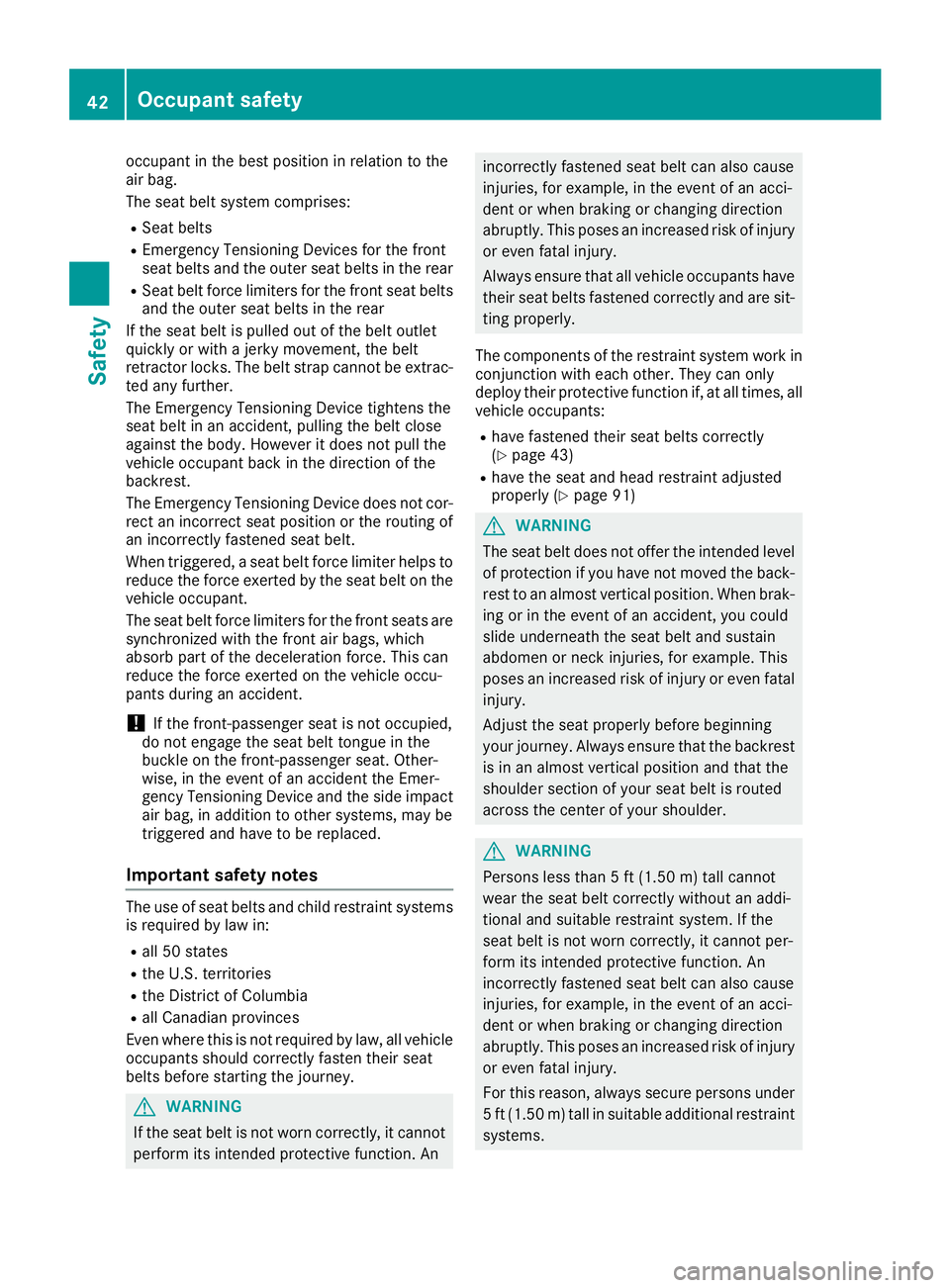
occupant
inthe best position inrelation tothe
air bag.
The seat beltsystem comprises:
R Seat belts
R Emergen cyTensionin gDevices forthe front
seat belts andtheouter seatbelts inthe rear
R Seat beltforce limiters forthe front seatbelts
and theouter seatbelts inthe rear
If the seat beltispulled outofthe belt outlet
quickly orwith ajerk ymovement ,the belt
retract orlocks. Thebelt strap cannotbe extr ac-
ted any further.
The Emergen cyTensionin gDevice tightensthe
seat beltinan accident ,pulling thebelt close
against thebody. However itdoes notpull the
vehicle occupant backinthe direction ofthe
backrest .
The Emergen cyTensionin gDevice doesnotcor-
rect anincorr ectseat position orthe routing of
an incorr ectlyfastened seatbelt.
When triggered, aseat beltforce limiter helpsto
reduce theforce exertedbythe seat beltonthe
vehicle occupant .
The seat beltforce limiters forthe front seats are
synchron izedwith thefront airbags, which
absorb partofthe deceleration force.Thiscan
reduce theforce exertedon the vehicle occu-
pants during anaccident .
! If
the front -passenger seatisnot occupied,
do not engage theseat belttongue inthe
buckle onthe front -passenger seat.Other-
wise, inthe event ofan accident theEmer-
gency Tensionin gDevice andtheside impact
air bag, inaddition toother systems, maybe
triggered andhave tobe replaced.
Import antsafety notes The
useofseat belts andchild restraint systems
is required bylaw in:
R all 50 states
R the U.S. territ ories
R the Distr ictofColumbia
R all Canadian provinces
Even where thisisnot required bylaw, allvehicle
occupant sshould correctlyfasten theirseat
belts before startingthe journey. G
WARNING
If the seat beltisnot worn correc tly,itcann ot
perform itsinten dedprotect ivefunct ion.An incorr
ectlyfastened seatbeltcanalso cause
injuries, forexample, inthe event ofan acci-
dent orwhen braking orchanging direction
abruptly. Thisposes anincreased riskofinjury
or even fatalinjury.
Always ensurethatallvehicle occupant shave
their seatbelts fastened correctlyand aresit-
ting properly.
The componen tsof the restraint systemworkin
conj unct ionwith each other. Theycanonly
deploy theirprotect ivefunct ionif,at all times, all
vehicle occupant s:
R have fastened theirseatbelts correc tly
(Y page 43)
R have theseat andhead restraint adjusted
properly (Ypage 91) G
WARNING
The seat beltdoes notoffer theinten dedlevel
of protect ionifyou have notmoved theback-
rest toan almost verticalposition. Whenbrak-
ing orinthe event ofan accident ,you could
slide underneath theseat beltandsustain
abdomen orneck injuries, forexample. This
poses anincreased riskofinjury oreven fatal
injury.
Adjust theseat properly beforebeginning
your journey. Alwaysensurethatthebackrest
is in an almost verticalposition andthat the
shoulder sectionofyour seatbeltisrouted
across thecent erofyour shoulder. G
WARNING
Persons lessthan 5ft (1.50 m)tall cann ot
wear theseat beltcorrec tlywithout anaddi-
tional andsuitable restraint system.Ifthe
seat beltisnot worn correc tly,itcann otper-
form itsinten dedprotect ivefunct ion.An
incorr ectlyfastened seatbeltcanalso cause
injuries, forexample, inthe event ofan acci-
dent orwhen braking orchanging direction
abruptly. Thisposes anincreased riskofinjury
or even fatalinjury.
For this reason, alwayssecure persons under
5 ft (1.50 m)tall insuitable additional restraint
systems. 42
Occupant
safetySafety
Page 50 of 330
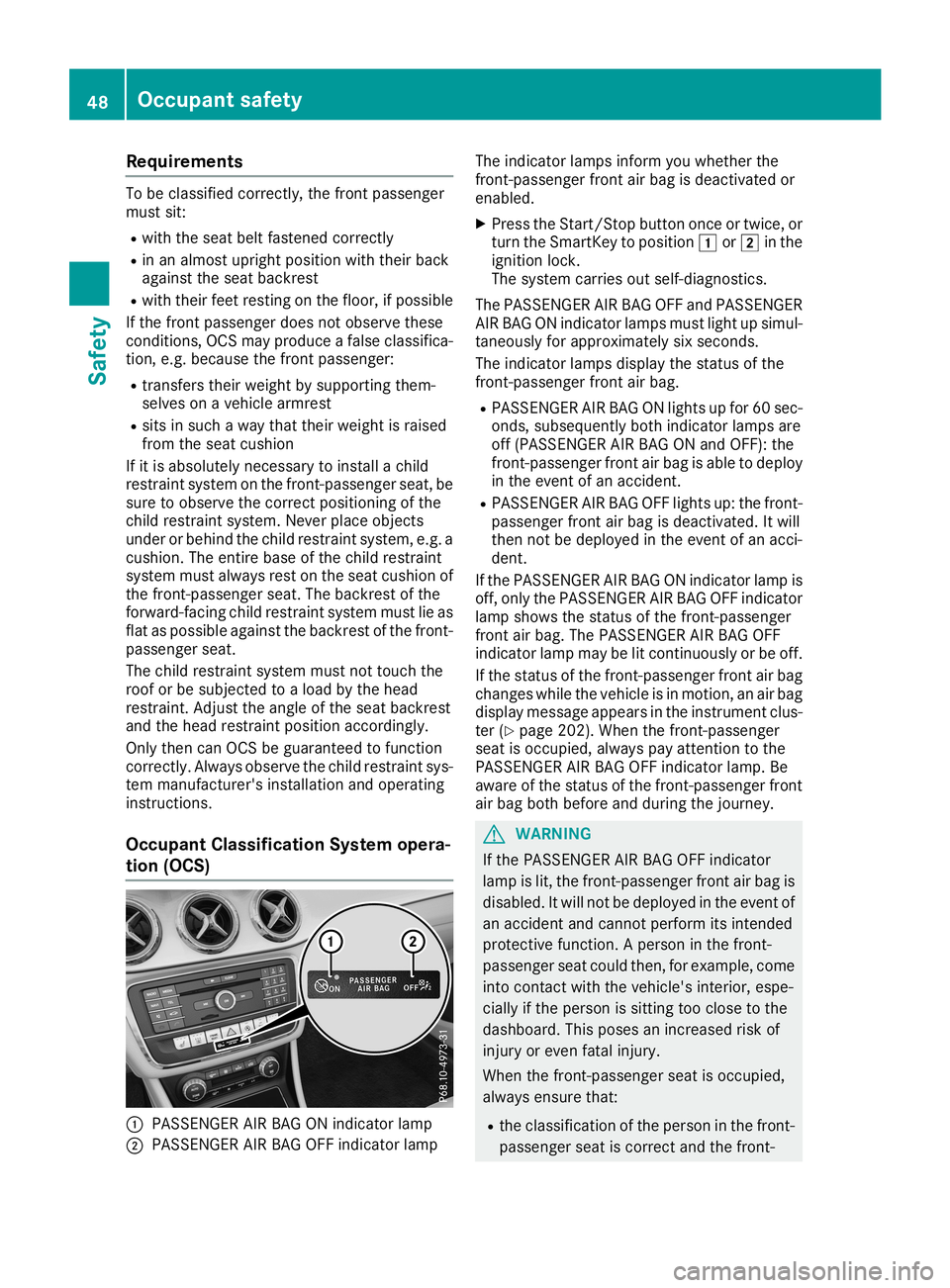
Requi
rements To
be classifiedcorre ctly,the front passe nger
mus tsit:
R with the seatbel tfas tened correctly
R in an almost uprig ht pos ition with thei rba ck
ag ainst the seatba ckrest
R with thei rfee tres ting onthe floor, ifpos sible
If the front passe nger doesnot observe these
condi tions,OC Smay produce afal se cla ssifica -
tion, e.g.because the front passe nger :
R trans ferstheirwe ight by supp orti ngthem-
sel ves onaveh iclearm rest
R sits insuch awa ythat theirwe ight israi sed
from theseatcus hion
If it is ab sol ute lyneces sary to insta lla chi ld
res trai ntsystem onthe front-p asseng ersea t,be
su re to obs erve thecorre ctpos itioning ofthe
chi ldres trai ntsystem. Neverpl ace obje cts
und eror beh indthe childres trai ntsystem, e.g.a
cus hion.The entir eba se ofthe childres trai nt
sy stem mustal wa ysres ton the seatcus hionof
the front-p asseng ersea t.The backrest ofthe
forw ard-faci ngchi ldres trai ntsystem mustlie as
fla tas pos sibleag ainst the backrest ofthe front-
pa sse nger seat.
The childres trai ntsystem mustnot touchthe
roo for be subjecte dto aload bythe head
res trai nt.Adju stthe angleof the seatba ckrest
and theheadres trai ntpos ition acco rdingly .
Only thencanOCSbe guara nteed tofuncti on
corre ctly.Alw aysobs erve thechildres trai ntsys-
tem manu facturer'sinsta llati on and operating
instru ctions .
Oc cupa ntClass ificati onSys tem opera-
tio n(O CS ) 0043
PASSENG ERAIR BAG ONindicator lamp
0044 PASSENG ERAIR BAG OFFindicator lamp The
indicator lamps informyouwh ethe rthe
front-p asseng erfront airba gis dea ctiva tedor
ena bled.
X Pre ssthe Start/Sto pbu tton once ortwi ce, or
turn theSmar tKeytopos ition 0047 or0048 inthe
ig niti onlock.
The system carriesou tsel f-di agnosti cs.
The PASSENG ERAIR BAG OFFandPASSENG ER
AIR BAG ONindicator lamps mustlight upsim ul-
tane ously for appro xima telysixseco nds.
The indicator lamps displ aythe statu sof the
front-p asseng erfront airba g.
R PASSENG ERAIR BAG ONlights upfor 60sec-
onds ,su bse quently bothindicator lamps are
off (PASSEN GERAIRBAG ONand OFF) :the
front-p asseng erfront airba gis ab leto dep loy
in the eventofan acci dent.
R PASSENG ERAIR BAG OFFlights up:the front-
pa sse nger front airba gis dea ctiva ted.Itwi ll
then notbedep loye din the eventofan acci -
dent.
If the PASSENG ERAIR BAG ONindicator lamp is
off, only thePASSENG ERAIR BAG OFFindicator
la mp showsthe statu sof the front-p asseng er
front airba g. The PASSENG ERAIR BAG OFF
ind icator lamp may belit continu ously orbe off.
If the statu sof the front-p asseng erfront airba g
cha nges while the vehicleis in moti on,anairba g
di spl aymes sage appea rsinthe instr umentclu s-
ter (Ypage 202). Whenthe front-p asseng er
sea tis occu pied, alwa yspayattenti ontothe
PASSENG ERAIR BAG OFFindicator lamp. Be
aw are ofthe statu sof the front-p asseng erfront
ai rba gboth before and during thejourney . G
WARNI
NG
If the PASSENG ERAIR BAG OFFindicator
la mp islit, the front-p asseng erfront airba gis
di sa bled. Itwi llnot bedep loye din the eventof
an acci dent andcanno tper form itsintend ed
pro tectiv efuncti on.Aper son inthe front-
pa sse nger seatcou ldthen, forexa mpl e,come
into conta ctwith the vehicle's inter ior, esp e-
cia lly if the person issitti ngtoo closetothe
da shb oard. Thispos esan incre ased riskof
inju ryor eve nfata linju ry.
Whe nthe front-p asseng ersea tis occu pied,
al wa ysensu rethat:
R the classifica tion ofthe person inthe front-
pa sse nger seatis corre ctand thefront- 48
Oc
cupan tsafe tySafe ty
Page 56 of 330
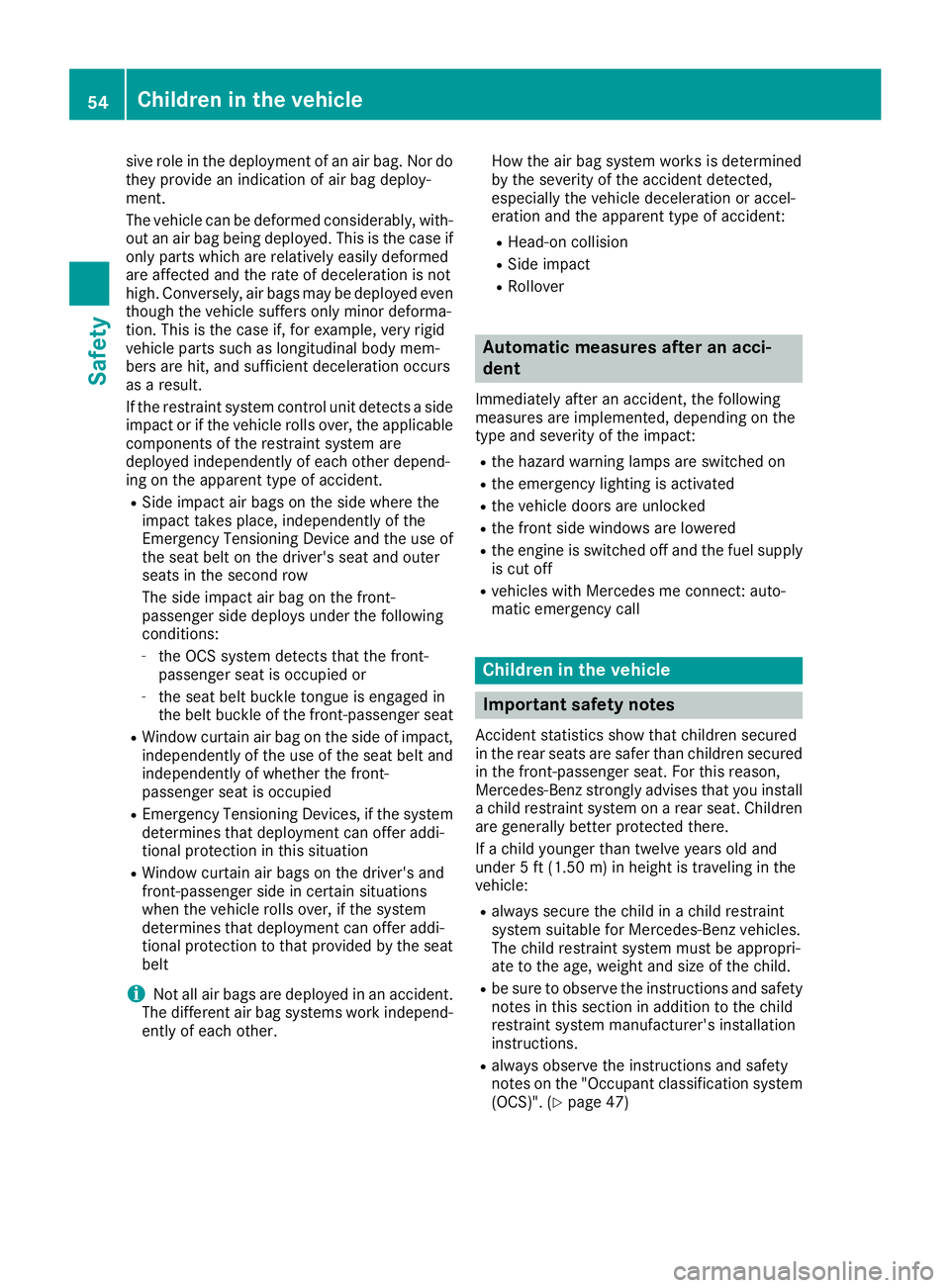
sive
roleinthe deploy mentofan air bag. Nordo
they provide anindication ofair bag deploy -
ment.
The vehicle canbedeformed considerably, with-
out anair bag being deploy ed.This isthe case if
only parts which arerelatively easilydeformed
are affected andtherate ofdeceleration isnot
high. Conversely, airbags maybedeploy edeven
though thevehicle suffersonlyminor deforma-
tion. Thisisthe case if,for example, veryrigid
vehicle partssuchaslongitudinal bodymem-
bers arehit,and sufficient deceleration occurs
as aresult.
If the restraint systemcontrolunit detects aside
impact orifthe vehicle rollsover, theappli cable
component sof the restraint systemare
deploy edindependently ofeach other depend-
ing onthe appa renttype ofaccident.
R Side impact airbags onthe side where the
impact takesplace, independently ofthe
Emergenc yTensioning Deviceandtheuse of
the seat beltonthe driver's seatandouter
seats inthe second row
The side impact airbag onthe front -
passenger sidedeploy sunder thefollowi ng
conditions:
- the OCS system detects thatthefront -
passenger seatisoccupied or
- the seat beltbuckle tongue isengaged in
the belt buckle ofthe front -passenger seat
R Window curtainairbag onthe side ofimpact,
independently ofthe use ofthe seat beltand
independently ofwhether thefront -
passenger seatisoccupied
R Emergenc yTensioning Devices,ifthe system
determines thatdeploy mentcanoffer addi-
tional protection inthis situation
R Window curtainairbags onthe driver's and
front -passenger sideincertain situations
when thevehicle rollsover, ifthe system
determines thatdeploy mentcanoffer addi-
tional protection tothat provided bythe seat
belt
i Not
allair bags aredeploy edinan accident.
The different airbag systems workindepend-
ently ofeach other. How
theairbag system worksisdetermined
by the severity ofthe accident detected,
especial lythe vehicle deceleration oraccel-
eration andtheappa renttype ofaccident:
R Head-on collision
R Side impact
R Roll over Automatic
measuresafteranacci-
dent
Immediately afteranaccident, thefollowi ng
measures areimplemented, dependingonthe
type andseverity ofthe impact:
R the hazard warning lampsareswitched on
R the emergency lightingisactivated
R the vehicle doorsareunlocked
R the front sidewindows arelowered
R the engine isswitched offand thefuel supply
is cut off
R vehicles withMercedes meconn ect:auto-
matic emergency call Children
inthe vehicl e Importa
ntsafety notes
Acc ident statistics showthatchildren secured
in the rear seats aresafer thanchildren secured
in the front -passenger seat.Forthis reason,
Mercedes-Benz stronglyadvisesthatyouinstall
a child restraint systemonarear seat. Children
are generally betterprotected there.
If achild younger thantwelve yearsoldand
under 5ft (1.50 m)inheight istraveling inthe
vehicle:
R alwa yssecure thechild inachild restraint
system suitable forMercedes-Benz vehicles.
The child restraint systemmustbeappropri-
ate tothe age, weight andsize ofthe child.
R be sure toobserve theinstruct ionsandsafety
notes inthis section inaddition tothe child
restraint systemmanufacturer's installation
instruct ions.
R alwa ysobserve theinstruct ionsandsafety
notes onthe "Occupant classification system
(OCS)". (Ypage 47) 54
Children
inthe vehicl eSafety
Page 57 of 330

G
WARNING
If you leavechild renunsu pervi sedinthe vehi-
cle, they couldset itin motion by,forexampl e:
R rele ase theparki ngbrake.
R shift theautomatic transmissi onout ofthe
parki ngposi tion P.
R start theengine.
In add ition, theymayopera tevehicl eequ ip-
ment andbecome trapped.There isarisk of
an accide ntand injury .
When leaving thevehicl e,alw aystake the
SmartKey withyouand lock thevehicl e.Never
lea vechild renunsu pervi sedinthe vehicl e. G
WARNING
If perso ns,particu larlychild renaresubjected
to prolo nged exposu reto extreme heator
cold, there isarisk ofinjury ,possi blyeven
fatal .Never leavechild renunattended inthe
vehicl e. G
WARNING
If the child restrai ntsystem issub jected to
dire ctsunli ght,parts maygetvery hot.Chil-
dren mayburn themsel vesonthese parts,
particu larlyon the metal partsofthe child
restrai ntsystem. Thereisarisk ofinjury .
If you leavethe vehicl e,taking thechild with
you ,alw aysensure thatthechild restrai nt
system isnot expose dto dire ctsunli ght.Pro-
tect itwith abla nket, forexampl e.Ifthe child
restrai ntsystem hasbeen expose dto dire ct
sunli ght,letitcool downbefore securingthe
child init. Never leavechild renunattended in
the vehicl e.
Alwa ysensure thatallvehicl eoccupa ntshave
their seatbeltsfastened correctly andaresitting
prope rly.Particu larattention mustbepaidto
child ren.
Observe thesafety notesonthe seat belt
(Y pag e42) and thenotes oncorrect useofseat
bel ts(Y pag e43).
A booster seatmaybenecessa ryto achie ve
prope rseat beltposi tioning forchild renover
40 lbs (18 kg)until theyreach aheig htwhere athree-poi
ntseat beltcan beprope rlyfastened
witho utabooster seat. Spec
ialseatbe ltretractor G
WARNING
If the seat beltis rele ased whiledrivi ng,the
child restrai ntsystem willno longer be
secure dprope rly.The speci alseat beltretrac-
tor isdisa bledand theinertia realdraw sin a
portion ofthe seat belt.The seat beltcannot
be immed iatelyrefastene d.There isan
increas edrisk ofinjury ,possi blyeven fatal.
Stop thevehicl eimmed iately,pay ing atten-
tion toroad andtraffic conditions. Reactivate
the speci alseat beltretractor andsecure the
child restrai ntsystem properly.
All seat beltsinthe vehicl e,except thedrive r's
seat belt,are equipped with aspeci alseat belt
retractor. Whenactivated,thespeci alseat belt
retractor ensuresthat theseat beltcannot
sla cken once thechild seatissecure d.
Install ingachild restrai ntsystem:
X Make sureyouobser vethe child restrai nt
system manufacturer's installationinstruc-
tions.
X Pul lthe seat beltsmoothly fromthebeltout-
let.
X Engage seatbelttongue inbel tbuckle .
Activating thespeci alseat beltretractor:
X Pul lthe seat beltout fullyand letthe inertia
reel retract itaga in.
Whil ethe seat beltis retracting, youshou ld
hear aratcheting sound.The speci alseat belt
retractor isenabl ed.
X Push thechild restrai ntsystem downso that
the seat beltis tight anddoes notloos en.
Remo vingthechild restrai ntsystem anddeac-
tivating thespeci alseat beltretractor:
X Make sureyouobser vethe child restrai nt
system manufacturer's installationinstruc-
tions.
X Press therelease button ofthe seat belt
buckle andguide the seat belttongue back
toward sthe beltsash guide.
The speci alseat beltretractor isdea ctivated. Chi
ldren inthe vehi cle
55Safety Z
Page 60 of 330
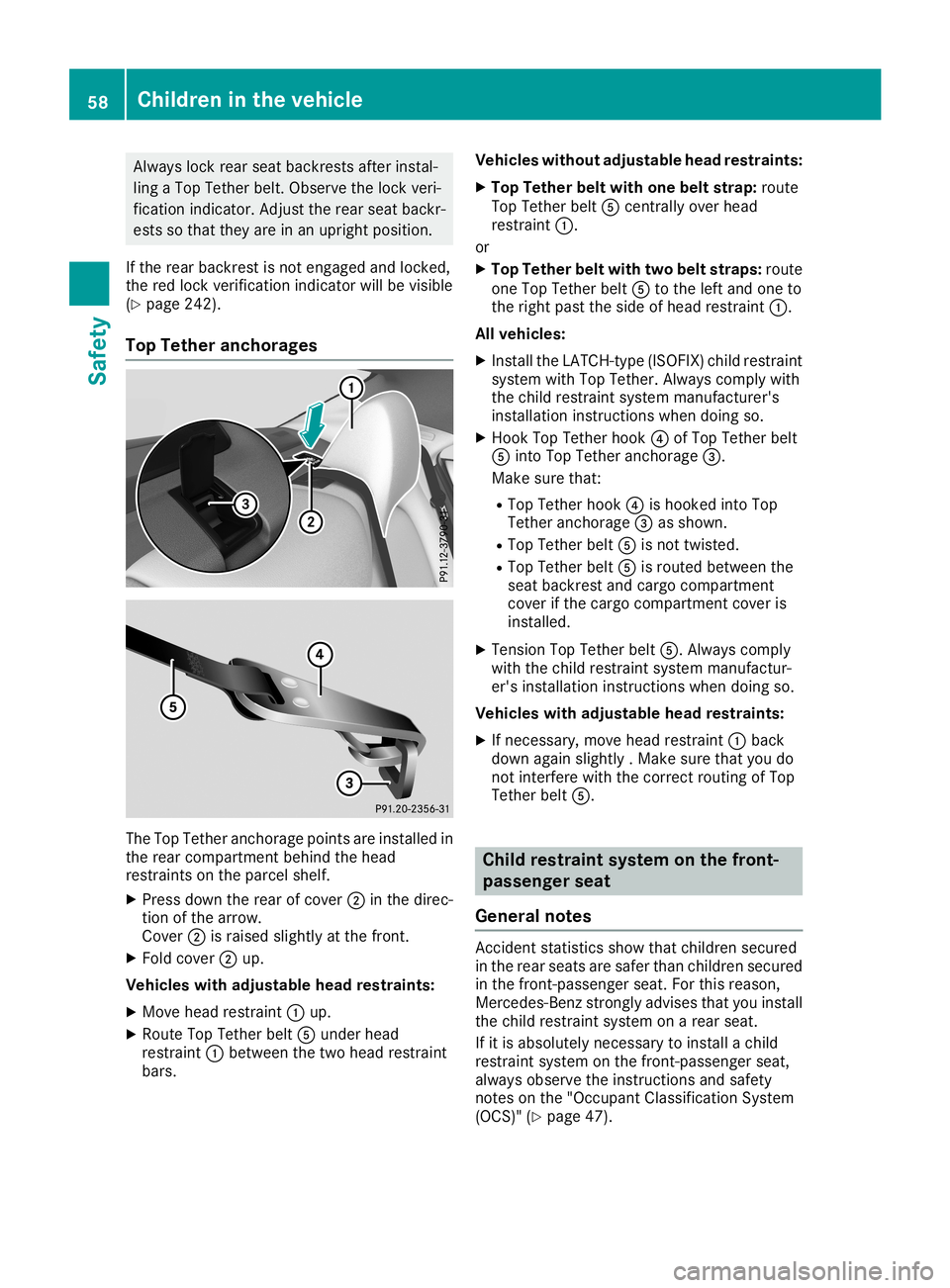
Alw
ayslo ck rea rsea tba ckres tsafte rins tal-
li ng aTop Tether belt. Obs ervethe lock ver i-
fica tionind icator. Adju stthe rearsea tba ckr-
ests sotha tthey arein an uprig ht positio n.
If the rearba ckres tis not engaged and locked ,
the red lock ver ificati onindicator willbe visible
(Y page 242 ).
Top Tethe ranc hora ges The
Top Tether anch oragepoints areins talledin
the rearcomp artment behind the head
res trai nts onthe parcel shelf.
X Pre ssdown the rearof cove r0044 inthe direc-
tio nof the arrow .
Co ver 0044israised slig htl yat the front.
X Fol dcove r0044 up.
Vehi cles with adjusta blehea dres train ts:
X Mov ehea dres trai nt0043 up.
X Ro ute Top Tether belt0083 und erhea d
res trai nt0043 betwe enthe two headres trai nt
ba rs. Vehi
cles withou tadjusta blehea dres train ts:
X Top Tethe rbe ltwi th onebe ltstrap: route
Top Tether belt0083 centra lly ove rhea d
res trai nt0043.
or X Top Tethe rbe ltwi th two beltstraps :rou te
one TopTether belt0083 tothe left and one to
the right past the side ofhea dres trai nt0043.
Al lve hic les:
X Insta llthe LATC H-typ e(ISO FIX) childres trai nt
sy stem with Top Tether .Alw ayscomp lywith
the childres trai ntsystem manuf actu rer's
ins tallatio nins truc tions when doing so.
X Hoo kTop Tether hook0085 ofTop Tether belt
0083 into TopTether anch orage0087.
Ma kesure tha t:
R Top Tether hook0085 ishoo ked into Top
Te ther anch orage0087 assho wn.
R Top Tether belt0083 isnot twisted .
R Top Tether belt0083 isrou ted betwe enthe
sea tba ckres tand cargocomp artment
cove rif the cargocomp artment coveris
ins talled.
X Te nsi on Top Tether belt0083. Alwayscomp ly
wi th the childres trai ntsystem manuf actu r-
er' sins tallatio nins truc tions when doing so.
Vehi cles with adjusta blehea dres train ts:
X Ifnece ssary,move headres trai nt0043 back
do wn again slig htl y.Ma kesure tha tyo udo
not interferewith the corr ectrouting ofTop
Te ther belt0083. Chi
ldres train tsys tem onthe fron t-
pass engerse at
Ge neral notes Accid
entstatistics showtha tchi ldren secured
in the rearsea tsaresa fer thanchi ldren secured
in the front-p asseng ersea t.For thisrea son,
Mer cedes-B enzstronglyad vis es tha tyo uins tall
the childres trai ntsystem onarea rsea t.
If it is ab sol ute lynece ssaryto ins talla chi ld
res trai ntsystem onthe front-p asseng ersea t,
al wa ysobser vethe instruc tions and safety
notes onthe "Occup antClas sifica tionSys tem
(OC S)"(Ypage 47) . 58
Ch
ildren inthe vehic leSafe ty
Page 61 of 330
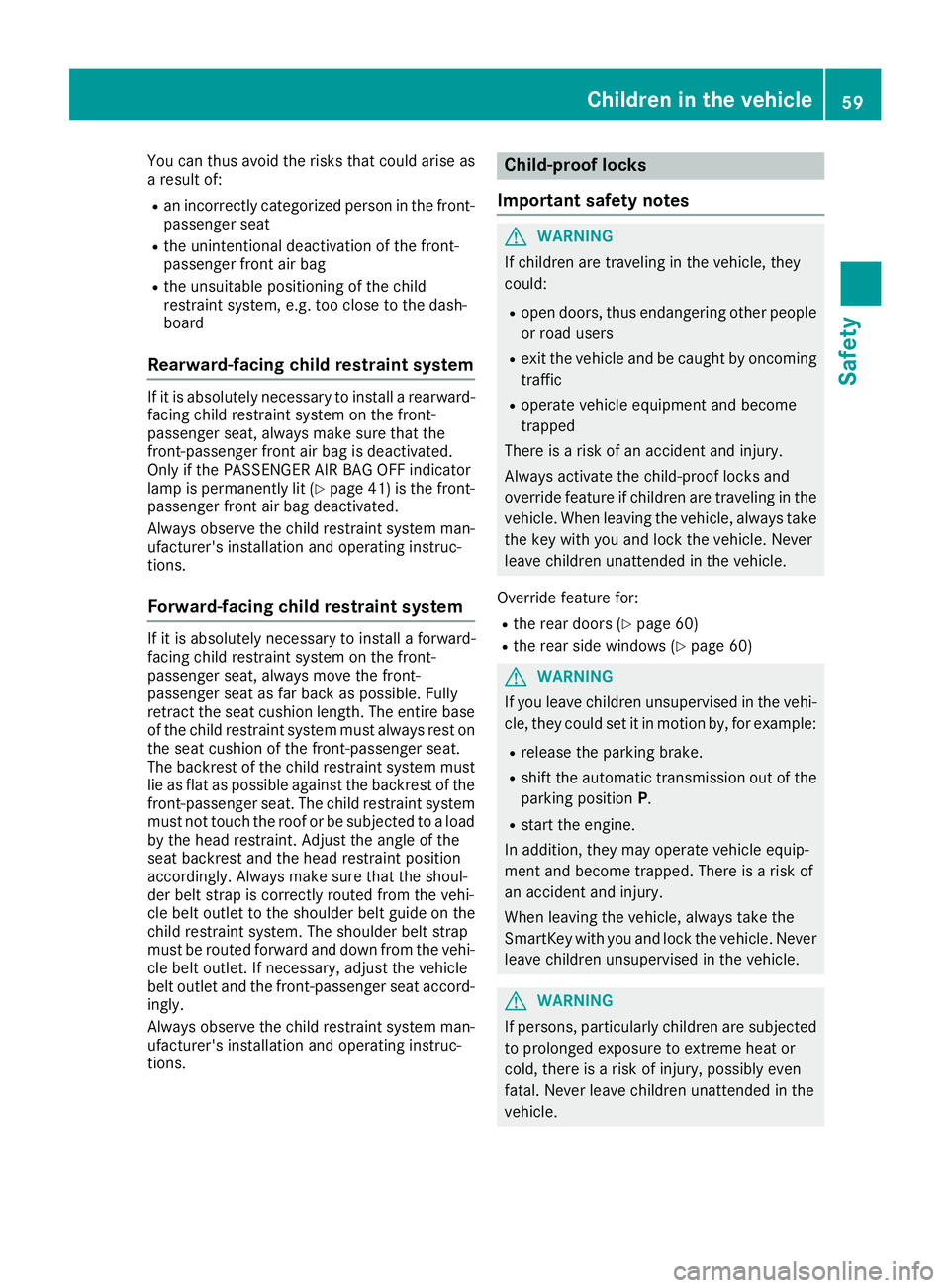
You
canthus avoid therisksthat could ariseas
a result of:
R an inc orre ctly cat egoriz edperson inthe fron t-
passen gerseat
R the unin tention aldeact ivationof the fron t-
passen gerfron tair bag
R the unsuit ableposit ioningof the child
rest raint syste m,e.g. tooclose tothe dash-
board
Rear ward -facing child restraint syst em If
it is absolute lynec essary toinst allarearward -
facin gchild restraint syste mon the fron t-
passen gerseat, always makesurethatthe
fron t-passen gerfron tair bag isdeact ivated.
Only ifthe PAS SENGER AIRBAGOFF indic ator
lamp isperman entlylit (Y page 41)isthe fron t-
passen gerfron tair bag deact ivated.
Always observethe child restraint syste mman-
ufact urer's installation andoperat inginst ruc-
tion s.
Forwar d-facing childrestraint syst em If
it is absolute lynec essary toinst allaforwar d-
facin gchild restraint syste mon the fron t-
passen gerseat, always movethefron t-
passen gerseat asfar back aspossible. Fully
ret ract theseat cushio nlengt h.The entirebase
of the child restraint syste mmust always reston
the seat cushio nof the fron t-passen gerseat.
The back restofthe child restraint syste mmust
lie asflat aspossible againsttheback restofthe
fron t-passen gerseat. Thechild restraint syste m
must nottouc hthe roof orbe subjec tedtoaload
by the head restraint .Adj ust the angle ofthe
seat backrestandthehead restraint position
acco rdingly. Always makesurethattheshoul-
der belt strap iscor rectlyrout edfrom thevehi-
cle belt outlet tothe shoulder beltguide onthe
child restraint syste m.The shoulder beltstrap
must berout edforwar dand down fromthevehi-
cle belt outlet .If nec essary, adjustthevehic le
belt outlet andthefron t-passen gerseat acco rd-
ingly.
Always observethe child restraint syste mman-
ufact urer's installation andoperat inginst ruc-
tion s. Child-
proof locks
Imp ortant safet ynotes G
WARN
ING
If childr enare traveling inthe vehic le,the y
could:
R open doors ,thus endan geringoth erpeople
or road users
R exit thevehic leand becaught byonc omin g
tr affic
R operat evehic leequipmen tand becom e
tr apped
There isarisk ofan accid entand injury.
Always activate thechild- proof locksand
over ridefeatureifchildr enare traveling inthe
vehic le.When leaving thevehic le,always take
the key with youand lock thevehic le.Never
leave childrenunat tended inthe vehic le.
Over ridefeature for:
R the rear doors (Ypage 60)
R the rear side windows (Ypage 60) G
WARN
ING
If you leave childrenunsuper visedinthe vehi-
cle, theycould setitin mot ionby,forexamp le:
R release thepark ingbrak e.
R shift theautomat ictransm ission outofthe
park ingposit ionP.
R star tthe engin e.
In addition ,the ymay operat evehic leequip-
men tand becom etrapped. Thereisarisk of
an accid entand injury.
When leaving thevehic le,always takethe
Smar tKey with youand lock thevehic le.Never
leave childrenunsuper visedinthe vehic le. G
WARN
ING
If person s,part icularly childrenare subjec ted
to prolon gedexpos uretoext reme heator
cold, thereisarisk ofinjury, possibly even
fatal. Never leavechildrenunat tended inthe
vehic le. Childr
eninthevehicle
59Safety Z